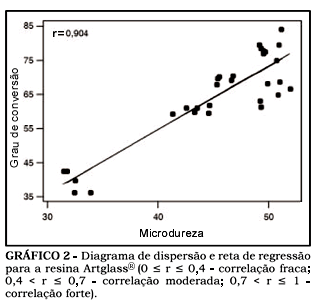The purpose of this study was to evaluate the correlation between degree of conversion and microhardness in dental composites, as well as the effect of the inorganic content and type of photo-curing unit on these parameters. Three indirect composites (ArtglassTM, SolidexTM and Zeta LCTM) were polymerized by means of three different laboratorial units (UniXSTM, SolidiliteTM and an experimental device). For each material, fifteen samples were prepared using a metal matrix. The degree of conversion was analyzed by means of infrared spectroscopy, and microhardness was also assessed. The inorganic content was measured by means of thermogravimetric analysis (TGA). The Pearson’s test was carried out in order to determine correlations. The degree of conversion of ArtglassTM ranged from 37.5% to 79.2%, and its microhardness, from 32.4 to 50.3 (r = 0.904). The degree of conversion of SolidexTM ranged from 41.2% to 60.4%, and its microhardness, from 33.3 to 44.1 (r = 0.707). The degree of conversion and the microhardness of Zeta LCTM ranged from 62.0% to 78.0% and from 22.6 to 33.6, respectively (r = 0.710). It was concluded that the utilization of different photo-curing units caused variations on the degree of conversion, as a result of specific characteristics of each unit. For each material, there was strong correlation between the degree of conversion and microhardness. In addition, when different materials were compared, microhardness was more affected by filler content than by the degree of conversion.
Composite resins; Inorganic particles







